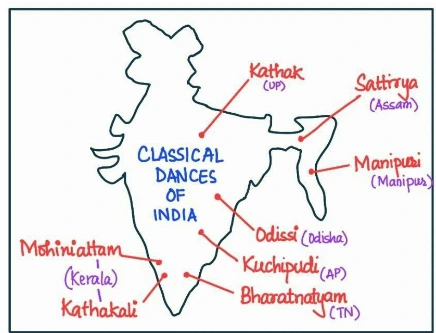Answer:
|
How to approach the question
- Introduction
- Write briefly about Indian classical dances.
- Body
- Explain the significance of Indian classical dances in preserving traditions.
- Explain the significance of Indian classical dances in preserving storytelling.
- Explain the significance of Indian classical dances in promoting artistic expression.
- Conclusion
- Conclude with Indian dances’ viewpoint towards asked factors.
|
Introduction
Indian classical dances are a rich and diverse art form that have been developed and nurtured over centuries in different regions of India deeply rooted in Indian culture, mythology, and spirituality. Example- Bharatnatyam.
Body
Indian classical dances on preserving traditions
- Preservation of Music: Odissi, originating from Odisha, showcases the rhythmic patterns of Odissi music.
 Ritualistic Significance: Mohiniyattam, associated with temples in Kerala, is performed as an offering to deities during festivals.
Ritualistic Significance: Mohiniyattam, associated with temples in Kerala, is performed as an offering to deities during festivals.- Symbolism and Gestures: Dances like Kathak and Manipuri employ intricate hand gestures and body movements, known as mudras, to convey meaning.
- Preservation through global recognition: Bollywood dance styles, influenced by classical forms like Kathak and Bharatanatyam, have gained popularity worldwide.
Preserving storytelling
- Tradition and Heritage: Kathakali from Kerala uses elaborate facial expressions and gestures to narrate mythological tales like the Ramayana and Mahabharata.
- Narrative Elements: In Mohiniyattam, a solo dance form from Kerala, the dancer uses graceful movements and subtle expressions to narrate stories of love and devotion.
- Music and Rhythm: In Kathak, the dancer’s footwork (tatkar) and rhythmic patterns (tukras) accentuate the storytelling, bringing the story to life.
- Regional Diversity: Manipuri dance from Manipur depicts stories from Vaishnavism and the life of Lord Krishna, while Kathakali from Kerala portrays tales from Hindu epics.
Promoting artistic expression
- Body language and gestures: For instance, in Kathak, the dancer’s footwork, spins, and graceful hand movements convey joy, sorrow, and love.
- Enhancing creativity and improvisation: In the Manipuri dance form, artists often incorporate spontaneous rhythmic patterns and improvisations while expressing devotion to Lord Krishna.
- Mudras: Different moods and expressions are expressed through the use of mudras. Example- In Bharatanatyam, approximately fifty one root mudras (hand/finger gestures) are used to communicate specific ideas, events, actions, or creatures.
- Integration: Classical dances such as Kathak promote integration of tabla and dance with jugalbandi.
Conclusion
Overall, Indian classical dances promote artistic expression through the preservation of cultural heritage, intricate body language, spiritual and emotional connections, storytelling and creativity, which has been important in global recognition of this cultural aspect of India.
To get PDF version, Please click on "Print PDF" button.
 Ritualistic Significance: Mohiniyattam, associated with temples in Kerala, is performed as an offering to deities during festivals.
Ritualistic Significance: Mohiniyattam, associated with temples in Kerala, is performed as an offering to deities during festivals.
Latest Comments